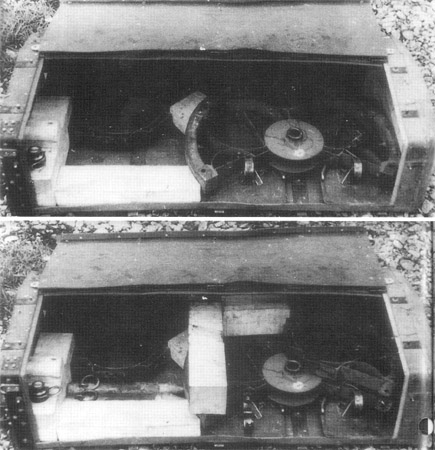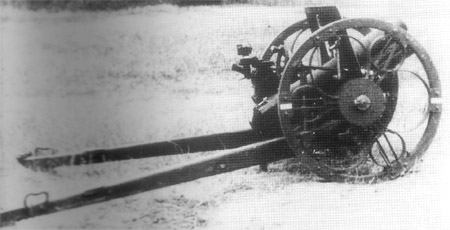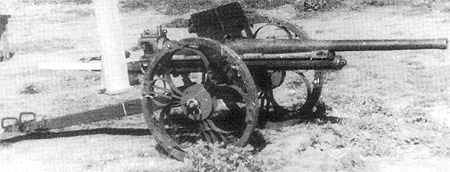Batallion level direct-fire support
Batallion level direct-fire support
Hi,
I ask your opinions about weapon class that seem to be missing in many armies inventories during WW2. Light infantry guns. German and Japanese infantry had those in large numbers as standard piece of equipment (7.5cm leIG 18 and 70mm Type 92). Dedicated direct fire weapons for general light fire support, MG-nest busting, counter to enemy AT-guns/manportable AT-teams, support weapon for combat in constructed areas able to lob shells through building windows from hundreds of metres, handy target of opportunity weapon in static warfare / sniper killer, AT- emergency backup, light enough to be manhandled to forward-line position comparatively easily (so, 15cm sIG 33 was something else.....).
Those tiny guns could fire also indirect, and act as kinda heavy for firepower mortars, but i think their sole reason for existence in world where 81mm Stokes-Brandt mortar was invented was the fast, forward-line direct fire capability.
(Soviets had heavier, much more powerfull and longer ranged 76.2mm m-1927 regimental gun, US had 75mm pack-howitzer, though originally ment for something else, and lacking firm place in organization - both are on upper end of this weapon class. Plus ofcourse "doorknocker" AT-guns of 37-45mm were eventually used to this infantry gun purpose everywhere - when their usefullness to intented task came to end, and there was lot of them available...).
Germans seemed to value the concept of light infantry gun highly, even after years of war experience. They gave considerable effort of developing even next generation already during the war. Also, i see PAW600 kinda infantry gun follow-up - more suited for AT-work.
Does anyone know about accuracy what was archieved with PAWs fin stabilized rounds. Could it compete with traditional rifled gun ?? I somehow doubt it...
Anyway, it was clearly an trade-off. Germans used to these weapons resources that were used in other armies to mortars. In your opinion - was it worth the effort ?? I am talking about WW2 timescale and possibilities, and especially on normal foot infantrys point-of-view: StuG-IIIs, etc. could not be everywhere where is need for direct fire support, and recoilless rifles have huge apetite, and some other limitations (have to arm 250 divisions - gun type weapon can lob 6kg shell to given distance with tiny fraction of propellant consumption of recoilless weapon - with very small report and not immediately revealing its position to everyone in line of sight). Ofcourse, i assume, an 60mm mortar could roughly lob equal amount of chemical energy to enemy positions in given time than 20 times heavier and 10 times more expensive 7.5cm infantry gun... but it could do nothing to MG-bunker with overhead protection of couple feet of soil/timber, or nothing to protect an unit of infantry caught in open terrain by T-26 light tank...
Regards, Mark V
I ask your opinions about weapon class that seem to be missing in many armies inventories during WW2. Light infantry guns. German and Japanese infantry had those in large numbers as standard piece of equipment (7.5cm leIG 18 and 70mm Type 92). Dedicated direct fire weapons for general light fire support, MG-nest busting, counter to enemy AT-guns/manportable AT-teams, support weapon for combat in constructed areas able to lob shells through building windows from hundreds of metres, handy target of opportunity weapon in static warfare / sniper killer, AT- emergency backup, light enough to be manhandled to forward-line position comparatively easily (so, 15cm sIG 33 was something else.....).
Those tiny guns could fire also indirect, and act as kinda heavy for firepower mortars, but i think their sole reason for existence in world where 81mm Stokes-Brandt mortar was invented was the fast, forward-line direct fire capability.
(Soviets had heavier, much more powerfull and longer ranged 76.2mm m-1927 regimental gun, US had 75mm pack-howitzer, though originally ment for something else, and lacking firm place in organization - both are on upper end of this weapon class. Plus ofcourse "doorknocker" AT-guns of 37-45mm were eventually used to this infantry gun purpose everywhere - when their usefullness to intented task came to end, and there was lot of them available...).
Germans seemed to value the concept of light infantry gun highly, even after years of war experience. They gave considerable effort of developing even next generation already during the war. Also, i see PAW600 kinda infantry gun follow-up - more suited for AT-work.
Does anyone know about accuracy what was archieved with PAWs fin stabilized rounds. Could it compete with traditional rifled gun ?? I somehow doubt it...
Anyway, it was clearly an trade-off. Germans used to these weapons resources that were used in other armies to mortars. In your opinion - was it worth the effort ?? I am talking about WW2 timescale and possibilities, and especially on normal foot infantrys point-of-view: StuG-IIIs, etc. could not be everywhere where is need for direct fire support, and recoilless rifles have huge apetite, and some other limitations (have to arm 250 divisions - gun type weapon can lob 6kg shell to given distance with tiny fraction of propellant consumption of recoilless weapon - with very small report and not immediately revealing its position to everyone in line of sight). Ofcourse, i assume, an 60mm mortar could roughly lob equal amount of chemical energy to enemy positions in given time than 20 times heavier and 10 times more expensive 7.5cm infantry gun... but it could do nothing to MG-bunker with overhead protection of couple feet of soil/timber, or nothing to protect an unit of infantry caught in open terrain by T-26 light tank...
Regards, Mark V
Last edited by Mark V on 20 Feb 2006, 22:59, edited 3 times in total.
- Davide Pastore
- Member
- Posts: 2768
- Joined: 26 Nov 2005, 23:05
- Location: Germagnano, Italy
- Contact:
I've often asked myself that same question. An IG seems a very nice weapons to have at hand... and still virtually no-one adopted it post-war, so there is obviously some good reason against it. Maybe - since it was a direct-fire weapon which needed to be brought relatively close to the enemy, inside MG range - it was an easy target.
Davide
Davide
Hi,Davide Pastore wrote:I've often asked myself that same question. An IG seems a very nice weapons to have at hand... and still virtually no-one adopted it post-war, so there is obviously some good reason against it. Maybe - since it was a direct-fire weapon which needed to be brought relatively close to the enemy, inside MG range - it was an easy target.
Davide
To my opinion recoilless rifles have taken the place, heavy and light ones - there is huge number of those in infantry units today. Cheap to buy in peacetime - very expensive to supply in wartime when you actually have to fire them. AT-guided missiles, MICVs, disposable AT-weapons with good range and punch, grenade MGs, automatic breech loaded heavy mortars in self propelled mounts are coming next
Anyway, none of the above was an issue during WW2. Panzerfausts/Bazookas/PIATs could fullfill only tiny fraction of jobs because their range limitations/inaccuracy, and mostly the light support weapon available was 60-81mm mortar. Direct fire assets were many time almost nonexistant. No hundred or so 25-30mm autocannons in fighting vehicles available for every infantry division at that time...
I don't think the machinegun was an danger, on the contrary - because light infantry gun was fielded primarily as MG killer WW1 and after - leIG barrel appearing from the bushes was many times last that MG-bunker crew saw in this life, even at long range. The gun was capable of max range of 4000 metres in indirect role.
Mark V
I thought the IGs were regimental assets, not battalion?
Anyway, basically, a waste of resources. Battalions have mortars, which can do the work of an IG, and do it over a wider area, faster, and cheaper. 'Proper' artillery is better utilised back where it can make full use of it's range right across the front, can be resupplied more easily, and is harder to CB.
Anyway, basically, a waste of resources. Battalions have mortars, which can do the work of an IG, and do it over a wider area, faster, and cheaper. 'Proper' artillery is better utilised back where it can make full use of it's range right across the front, can be resupplied more easily, and is harder to CB.
To my understanding regimental infantry gun companys light platoons mostly operated at frontline with batallions. The heavy platoon with 15cm guns were kept farther from line, as "regiment commanders artillery".
But you are right, not organic part of batallion organization (though IIRC some Waffen-SS batallions had leIGs in their Heavy Company).
Mark V
But you are right, not organic part of batallion organization (though IIRC some Waffen-SS batallions had leIGs in their Heavy Company).
Mark V
Hi,
There is an interesting by-line to the German utilization to these type of guns - for airfield defence against paratroopers. Please see:
http://www.gyges.dk/fliegerhorst_grove2b.htm
bregds
SES
There is an interesting by-line to the German utilization to these type of guns - for airfield defence against paratroopers. Please see:
http://www.gyges.dk/fliegerhorst_grove2b.htm
bregds
SES
Mark VMark V wrote:To my understanding regimental infantry gun companys light platoons mostly operated at frontline with batallions. The heavy platoon with 15cm guns were kept farther from line, as "regiment commanders artillery".
But you are right, not organic part of batallion organization (though IIRC some Waffen-SS batallions had leIGs in their Heavy Company).
Mark V
This is a question that has been puzzling me for a long time as well. I would welcome some sources on your statements above for this reason. My interest is a bit personal, since my grandfather was first trained as an IG gunner in 1935/6, in Delmenhorst, IIRC.
From my understanding, the Germans loved their IGs (in the same way the Red Army had a very soft spot for direct fire support), and used a lot of their own, and captured Soviet 7,62cm m1927 IGs. But how is something I am much less firm on. I know that it depended partly on the situation - e.g. at the Volkhov the light IG was often the only artillery weapon available at all, due to mobility restrictions in the swamps for heavier pieces. I know that there were reports during Barbarossa in which the Pak 35/36 was credited with being a superb IG, even when it was clear that it had become pretty useless as an AT weapon - presumably because of its higher precision, compared to the lIG18. The sIG33 was too heavy, according to von Senger und Etterlin, so it would have been useless in forward defense, unless it was a really desperate situation. I have seen a report on Iassy-Kishinev where it appears that the IG company was in a rearward position when it was overrun.
My guess is that during attacks the lIG would be well forward, to help suppress identified resistance nests, e.g. MG positions, bunkers. In defense it would probably be concentrated at the regimental commander's level, IF the regiment was not covering an area where it would be impossible to cover the range of teh defensive positions with the IGs (e.g. Byelorussia in 1944). It simply makes more sense to concentrate the firepower in those cases. A salvo of 75mm with some 150mm intermixed will probably have an impact on an infantry attack, while a single platoon with two guns in direct fire will not have that same impact.

Propaganda - postcard from my grandfather's collection

And reality - my grandfather is the second man in the forward line.
Great topic!
All the best
Andreas
Hi.
The japanese infantry used three types of infantry guns:
- type 94 rapid fire infantry gun for light direct fire on close ranges with up to 20 rpm

- type 92 70 mm battlion gun for short range direct and indirect fire at high angle with up to 15 rpm
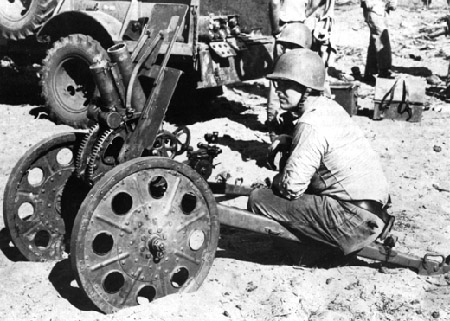
- type 41 75 mm pack gun for medium range direct fire with up to 12 rpm and anti tank fire. The HEAT round introduced 1940 was able to penetrate the Mathilda II
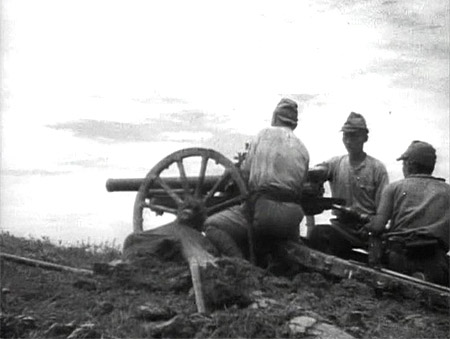
All these guns were very light and easy to transport even cross-country. They were small so no larger entrenchments were necessary. A qick change of the firing position was no problem.
The japanese close support fire was very effective and was able to equalize the lack of at-abilities and of adequat infantry rifles and machine guns a little bit.
Yours
tom!
The japanese infantry used three types of infantry guns:
- type 94 rapid fire infantry gun for light direct fire on close ranges with up to 20 rpm

- type 92 70 mm battlion gun for short range direct and indirect fire at high angle with up to 15 rpm

- type 41 75 mm pack gun for medium range direct fire with up to 12 rpm and anti tank fire. The HEAT round introduced 1940 was able to penetrate the Mathilda II

All these guns were very light and easy to transport even cross-country. They were small so no larger entrenchments were necessary. A qick change of the firing position was no problem.
The japanese close support fire was very effective and was able to equalize the lack of at-abilities and of adequat infantry rifles and machine guns a little bit.
Yours
tom!
Andreas,
Statement is too strong word. Better is to say random one, or two-liner mentions about weapon or its use that i have stumbled - and the technical abilities of weapon itself. The way you described the use is propably better. I am in similar situation as you - the weapon was standard piece of equipment, and integral to German Heer, fielded in huge numbers, but recollections about its use are seldomly found. Why is that BTW ?? - was the weapon so "boring", "exciting as bread", to Germans that little is written about its combat-use ?? It is like mortar troops, very little good descriptions - or i have not found them...
Like always, the flexibility of German organization and to them typical "kampfgruppe" -thinking makes it all the more difficult.
Anyway: What i know is that technically you don't build such weapon if you don't value its direct fire abilities highly. Using leIG only as "mortar" would not be economical - like i said 60mm mortar is tough competition to 7.5cm leIG in pure shell lobbing business...
15cm sIG 33 is an mystery to me. Sure, good bunker buster (propably with forward observer, and firing indirectly) and excellent in self-propelled mount, but seriously - weapon of that weight down to regimental level ?? - having different ammo than artillery arms howitzers ?? The logistical and mobility problems seem obvious, and was there really something that 15cm sIG could do that 10.5cm leFH could not had sufficed ?? Didn't the Germans actually little by little had started to replace sIGs with 120mm mortars ??
What is very clear is that many armies, Finnish Army among them, suffered from very serious lack of weapons in the role that leIG was specifically designed. We had quite many 20mm AT-rifles, but they were on light side on firepower, and we did not had excess of light AT-guns to be "wrongly deployed" (AT-defence point of view) to frontline during attack to support advancing infantry. We also have countless number of recollections of invidual soldiers having to do the dirty job with satchel charges, etc.. because there just weren't any direct fire asset that could deal with MG-bunker. Somehow it seems that many, many lives would had saved in our own army if we would had had decent numbers of leIG type weapons...
Excellent photos with personal point of view !! Thanks.
Regards, Mark V
Statement is too strong word. Better is to say random one, or two-liner mentions about weapon or its use that i have stumbled - and the technical abilities of weapon itself. The way you described the use is propably better. I am in similar situation as you - the weapon was standard piece of equipment, and integral to German Heer, fielded in huge numbers, but recollections about its use are seldomly found. Why is that BTW ?? - was the weapon so "boring", "exciting as bread", to Germans that little is written about its combat-use ?? It is like mortar troops, very little good descriptions - or i have not found them...
Like always, the flexibility of German organization and to them typical "kampfgruppe" -thinking makes it all the more difficult.
Anyway: What i know is that technically you don't build such weapon if you don't value its direct fire abilities highly. Using leIG only as "mortar" would not be economical - like i said 60mm mortar is tough competition to 7.5cm leIG in pure shell lobbing business...
15cm sIG 33 is an mystery to me. Sure, good bunker buster (propably with forward observer, and firing indirectly) and excellent in self-propelled mount, but seriously - weapon of that weight down to regimental level ?? - having different ammo than artillery arms howitzers ?? The logistical and mobility problems seem obvious, and was there really something that 15cm sIG could do that 10.5cm leFH could not had sufficed ?? Didn't the Germans actually little by little had started to replace sIGs with 120mm mortars ??
What is very clear is that many armies, Finnish Army among them, suffered from very serious lack of weapons in the role that leIG was specifically designed. We had quite many 20mm AT-rifles, but they were on light side on firepower, and we did not had excess of light AT-guns to be "wrongly deployed" (AT-defence point of view) to frontline during attack to support advancing infantry. We also have countless number of recollections of invidual soldiers having to do the dirty job with satchel charges, etc.. because there just weren't any direct fire asset that could deal with MG-bunker. Somehow it seems that many, many lives would had saved in our own army if we would had had decent numbers of leIG type weapons...
Excellent photos with personal point of view !! Thanks.
Regards, Mark V
Tom,
That Japanese Type 92 IG is real gem.
It is so unbelievable compact. How it could be said that light IGs were hard to manhandle ?? - put 4 strong men to the job and that thing will fly in firm terrain, couple more men and you could literally drag/carry it through everything imaginable.
Around 200 kilos if i remember correctly ??.... Not bad, not bad at all, as weapon is moved in ready to fire state, and could fire in seconds after arriving to firing position.
Mark V
That Japanese Type 92 IG is real gem.
It is so unbelievable compact. How it could be said that light IGs were hard to manhandle ?? - put 4 strong men to the job and that thing will fly in firm terrain, couple more men and you could literally drag/carry it through everything imaginable.
Around 200 kilos if i remember correctly ??.... Not bad, not bad at all, as weapon is moved in ready to fire state, and could fire in seconds after arriving to firing position.
Mark V
- T. A. Gardner
- Member
- Posts: 3568
- Joined: 02 Feb 2006, 01:23
- Location: Arizona
Battalion and regimental guns
Most nations provided some sort of artillery support at both battalion and regimental level. Many less mechanized nations chose to supply specialized "infantry" guns (small howitzers) for this role. The Germans, Japanese and Russians all provided such guns. These were either in the form of smaller anti-tank guns 37mm or 45 mm early in the war or, 70 to 76.2 mm small howitzers. Generally, each battalion got a pair sometimes a pair of each anti-tank guns and howitzers. The British and US with their more readily available artillery support and being more mechanized forewent using similar guns instead providing just anti-tank guns. In both cases these were typically the 57mm / 6 pdr by mid war.
At the regiment level these armies provided a battery of regimental guns. For the Germans this was supposed to be a mix of 7.5cm and 15 cm infantry guns (6 + 2). Late in the war 12cm mortars were sometimes substituted (and on paper were more often). The Soviets, with their preference for mortars provided 12cm pieces for this function. The Japanese tried to provide a battery of 75mm field pieces but this was not always available. The US provided a battery of 105mm howitzers given the availability of tow vehicles where their weight was not a big issue. The British, apparently on the basis of having more accessable division level artillery, did not provide such guns to their divisions. From mid-war there was the inclusion of a machinegun battalion that included 16 4.2" mortars that could function in this role.
The big reason that infantry guns were provided to begin with was simply one of providing some artillery support at each level of the division sturcture. For nations with less developed communications systems this was an important feature. It gave commanders at various levels access to at least some artillery. As commnications improves this need is often lessened (although I have no doubt that many commanders would argue that point) as a more centralized fire support system is available.
At the regiment level these armies provided a battery of regimental guns. For the Germans this was supposed to be a mix of 7.5cm and 15 cm infantry guns (6 + 2). Late in the war 12cm mortars were sometimes substituted (and on paper were more often). The Soviets, with their preference for mortars provided 12cm pieces for this function. The Japanese tried to provide a battery of 75mm field pieces but this was not always available. The US provided a battery of 105mm howitzers given the availability of tow vehicles where their weight was not a big issue. The British, apparently on the basis of having more accessable division level artillery, did not provide such guns to their divisions. From mid-war there was the inclusion of a machinegun battalion that included 16 4.2" mortars that could function in this role.
The big reason that infantry guns were provided to begin with was simply one of providing some artillery support at each level of the division sturcture. For nations with less developed communications systems this was an important feature. It gave commanders at various levels access to at least some artillery. As commnications improves this need is often lessened (although I have no doubt that many commanders would argue that point) as a more centralized fire support system is available.
Artillery doctrine changed & evolved as the war progressed. I have a little info on German artillery doctrine of 1941/42, that might be relevant to this topic.
"Each artillery Abteilung has a forward observer, these are allocated to Battalions/Abteilungen within the Division, at the Divisional commanders discretion. In addittion to which, any Battalion/Abteilung commander may request artillery support, acting himself or delegating a forward observer. Such requests however, are subordinate to simultaneous requests from the Artillery Abteilung forward observers.
Fire is usually at Abteilung or Regimental level, it is rarely if ever broken down to batterie level."
The example above, applied to a Panzer Division, therefore may not hold good with an Infantry Division. It certainly would not apply to an independent Battalion.
Generally speaking, within a Panzer Division, the two 10.5 cm Abteilungen observers, would be allocated, one each, to the Division's Panzer Battalions. The remaining 15.0 cm Abteilung observer would be allocated as circumstances dictated.
"Each artillery Abteilung has a forward observer, these are allocated to Battalions/Abteilungen within the Division, at the Divisional commanders discretion. In addittion to which, any Battalion/Abteilung commander may request artillery support, acting himself or delegating a forward observer. Such requests however, are subordinate to simultaneous requests from the Artillery Abteilung forward observers.
Fire is usually at Abteilung or Regimental level, it is rarely if ever broken down to batterie level."
The example above, applied to a Panzer Division, therefore may not hold good with an Infantry Division. It certainly would not apply to an independent Battalion.
Generally speaking, within a Panzer Division, the two 10.5 cm Abteilungen observers, would be allocated, one each, to the Division's Panzer Battalions. The remaining 15.0 cm Abteilung observer would be allocated as circumstances dictated.
David,
The infantry gun company is little different thing. Not part of artillery arm of division. Those men manning the weapons were not artillerymen, but infantry soldiers.
Artillery regiment supported the division and had equipment for that. They normally stayed well away from direct fire support range. Infantry guns were different breed. Close fire support weapons available for infantry unit commander, subjected down even to company/batallion level when needed, commanded by regiment commander.
Regards, Mark V
The infantry gun company is little different thing. Not part of artillery arm of division. Those men manning the weapons were not artillerymen, but infantry soldiers.
Artillery regiment supported the division and had equipment for that. They normally stayed well away from direct fire support range. Infantry guns were different breed. Close fire support weapons available for infantry unit commander, subjected down even to company/batallion level when needed, commanded by regiment commander.
Regards, Mark V
